Antibody data
- Antibody Data
- Antigen structure
- References [45]
- Comments [0]
- Validations
- Immunocytochemistry [2]
- Other assay [15]
Submit
Validation data
Reference
Comment
Report error
- Product number
- 32-3300 - Provider product page

- Provider
- Invitrogen Antibodies
- Product name
- SKP2 Monoclonal Antibody (SKP2-8D9)
- Antibody type
- Monoclonal
- Antigen
- Recombinant full-length protein
- Reactivity
- Human
- Host
- Mouse
- Isotype
- IgG
- Antibody clone number
- SKP2-8D9
- Vial size
- 100 μg
- Concentration
- 0.5 mg/mL
- Storage
- -20°C
Submitted references Artemisinin Mediates Its Tumor-Suppressive Activity in Hepatocellular Carcinoma Through Targeted Inhibition of FoxM1.
Discriminative SKP2 Interactions with CDK-Cyclin Complexes Support a Cyclin A-Specific Role in p27KIP1 Degradation.
ERAP1 promotes Hedgehog-dependent tumorigenesis by controlling USP47-mediated degradation of βTrCP.
Downregulation of SRPK2 promotes cell cycle arrest though E2F1 in non-small cell lung cancer.
Down-regulation of Skp2 expression inhibits invasion and lung metastasis in osteosarcoma.
Skp2-dependent reactivation of AKT drives resistance to PI3K inhibitors.
SKP2- and OTUD1-regulated non-proteolytic ubiquitination of YAP promotes YAP nuclear localization and activity.
SIRT6-dependent cysteine monoubiquitination in the PRE-SET domain of Suv39h1 regulates the NF-κB pathway.
Mechanical cue-induced YAP instructs Skp2-dependent cell cycle exit and oncogenic signaling.
The co-existence of transcriptional activator and transcriptional repressor MEF2 complexes influences tumor aggressiveness.
TGF-β activates APC through Cdh1 binding for Cks1 and Skp2 proteasomal destruction stabilizing p27kip1 for normal endometrial growth.
Upregulation of cyclin-dependent kinase inhibitors CDKN1B and CDKN1C in hepatocellular carcinoma-derived cells via goniothalamin-mediated protein stabilization and epigenetic modifications.
Skp2-macroH2A1-CDK8 axis orchestrates G2/M transition and tumorigenesis.
SKP2 is a direct transcriptional target of MYCN and a potential therapeutic target in neuroblastoma.
Exposure of neuroblastoma cell lines to imatinib results in the upregulation of the CDK inhibitor p27(KIP1) as a consequence of c-Abl inhibition.
CSN6 drives carcinogenesis by positively regulating Myc stability.
RASSF1A inactivation unleashes a tumor suppressor/oncogene cascade with context-dependent consequences on cell cycle progression.
Epidermal growth factor upregulates Skp2/Cks1 and p27(kip1) in human extrahepatic cholangiocarcinoma cells.
Uncovering the role of APC-Cdh1 in generating the dynamics of S-phase onset.
BRD4 sustains melanoma proliferation and represents a new target for epigenetic therapy.
Designer reagents for mass spectrometry-based proteomics: clickable cross-linkers for elucidation of protein structures and interactions.
Modulation of AKT activity is associated with reversible dormancy in ascites-derived epithelial ovarian cancer spheroids.
von Hippel-Lindau protein promotes Skp2 destabilization on DNA damage.
Clinical relevance of SKP2 alterations in metastatic melanoma.
In CD28-costimulated human naïve CD4+ T cells, I-κB kinase controls the expression of cell cycle regulatory proteins via interleukin-2-independent mechanisms.
The human COP9 signalosome protects ubiquitin-conjugating enzyme 3 (UBC3/Cdc34) from beta-transducin repeat-containing protein (betaTrCP)-mediated degradation.
The human papillomavirus type 18 E2 protein is a cell cycle-dependent target of the SCFSkp2 ubiquitin ligase.
Chemical genetics approach to restoring p27Kip1 reveals novel compounds with antiproliferative activity in prostate cancer cells.
Mechanoregulation of proliferation.
Skp2 regulates G2/M progression in a p53-dependent manner.
Targeting the p27 E3 ligase SCF(Skp2) results in p27- and Skp2-mediated cell-cycle arrest and activation of autophagy.
Disrupting Skp2-cyclin A interaction with a blocking peptide induces selective cancer cell killing.
Mutant B-RAF signaling and cyclin D1 regulate Cks1/S-phase kinase-associated protein 2-mediated degradation of p27Kip1 in human melanoma cells.
The COP9 signalosome regulates Skp2 levels and proliferation of human cells.
Skp2 contains a novel cyclin A binding domain that directly protects cyclin A from inhibition by p27Kip1.
The pT1a and pT1b category subdivision in renal cell carcinoma: is it reflected by differences in tumour biology?
Downregulation of Skp2 and p27/Kip1 synergistically induces apoptosis in T98G glioblastoma cells.
Ubiquitination and proteolysis of cancer-derived Smad4 mutants by SCFSkp2.
Tuberin binds p27 and negatively regulates its interaction with the SCF component Skp2.
Role of RhoA, mDia, and ROCK in cell shape-dependent control of the Skp2-p27kip1 pathway and the G1/S transition.
Cyclin-dependent kinases phosphorylate human Cdt1 and induce its degradation.
The SCF(Skp2) ubiquitin ligase complex interacts with the human replication licensing factor Cdt1 and regulates Cdt1 degradation.
The F-box protein SKP2 mediates androgen control of p27 stability in LNCaP human prostate cancer cells.
The F-box protein SKP2 mediates androgen control of p27 stability in LNCaP human prostate cancer cells.
S-phase kinase-associated protein 2 expression in non-Hodgkin's lymphoma inversely correlates with p27 expression and defines cells in S phase.
Nandi D, Cheema PS, Singal A, Bharti H, Nag A
Frontiers in oncology 2021;11:751271
Frontiers in oncology 2021;11:751271
Discriminative SKP2 Interactions with CDK-Cyclin Complexes Support a Cyclin A-Specific Role in p27KIP1 Degradation.
Salamina M, Montefiore BC, Liu M, Wood DJ, Heath R, Ault JR, Wang LZ, Korolchuk S, Baslé A, Pastok MW, Reeks J, Tatum NJ, Sobott F, Arold ST, Pagano M, Noble MEM, Endicott JA
Journal of molecular biology 2021 Mar 5;433(5):166795
Journal of molecular biology 2021 Mar 5;433(5):166795
ERAP1 promotes Hedgehog-dependent tumorigenesis by controlling USP47-mediated degradation of βTrCP.
Bufalieri F, Infante P, Bernardi F, Caimano M, Romania P, Moretti M, Lospinoso Severini L, Talbot J, Melaiu O, Tanori M, Di Magno L, Bellavia D, Capalbo C, Puget S, De Smaele E, Canettieri G, Guardavaccaro D, Busino L, Peschiaroli A, Pazzaglia S, Giannini G, Melino G, Locatelli F, Gulino A, Ayrault O, Fruci D, Di Marcotullio L
Nature communications 2019 Jul 24;10(1):3304
Nature communications 2019 Jul 24;10(1):3304
Downregulation of SRPK2 promotes cell cycle arrest though E2F1 in non-small cell lung cancer.
Li X, Yang S, Zhang M, Xie S, Xie Z
European journal of histochemistry : EJH 2019 Dec 11;63(4)
European journal of histochemistry : EJH 2019 Dec 11;63(4)
Down-regulation of Skp2 expression inhibits invasion and lung metastasis in osteosarcoma.
Zhang Y, Zvi YS, Batko B, Zaphiros N, O'Donnell EF, Wang J, Sato K, Yang R, Geller DS, Koirala P, Zhang W, Du X, Piperdi S, Liu Y, Zheng D, Roth M, Gill J, Zhang J, Ren T, Gorlick R, Zi X, Hoang BH
Scientific reports 2018 Sep 24;8(1):14294
Scientific reports 2018 Sep 24;8(1):14294
Skp2-dependent reactivation of AKT drives resistance to PI3K inhibitors.
Clement E, Inuzuka H, Nihira NT, Wei W, Toker A
Science signaling 2018 Mar 13;11(521)
Science signaling 2018 Mar 13;11(521)
SKP2- and OTUD1-regulated non-proteolytic ubiquitination of YAP promotes YAP nuclear localization and activity.
Yao F, Zhou Z, Kim J, Hang Q, Xiao Z, Ton BN, Chang L, Liu N, Zeng L, Wang W, Wang Y, Zhang P, Hu X, Su X, Liang H, Sun Y, Ma L
Nature communications 2018 Jun 11;9(1):2269
Nature communications 2018 Jun 11;9(1):2269
SIRT6-dependent cysteine monoubiquitination in the PRE-SET domain of Suv39h1 regulates the NF-κB pathway.
Santos-Barriopedro I, Bosch-Presegué L, Marazuela-Duque A, de la Torre C, Colomer C, Vazquez BN, Fuhrmann T, Martínez-Pastor B, Lu W, Braun T, Bober E, Jenuwein T, Serrano L, Esteller M, Chen Z, Barceló-Batllori S, Mostoslavsky R, Espinosa L, Vaquero A
Nature communications 2018 Jan 9;9(1):101
Nature communications 2018 Jan 9;9(1):101
Mechanical cue-induced YAP instructs Skp2-dependent cell cycle exit and oncogenic signaling.
Jang W, Kim T, Koo JS, Kim SK, Lim DS
The EMBO journal 2017 Sep 1;36(17):2510-2528
The EMBO journal 2017 Sep 1;36(17):2510-2528
The co-existence of transcriptional activator and transcriptional repressor MEF2 complexes influences tumor aggressiveness.
Di Giorgio E, Franforte E, Cefalù S, Rossi S, Dei Tos AP, Brenca M, Polano M, Maestro R, Paluvai H, Picco R, Brancolini C
PLoS genetics 2017 Apr;13(4):e1006752
PLoS genetics 2017 Apr;13(4):e1006752
TGF-β activates APC through Cdh1 binding for Cks1 and Skp2 proteasomal destruction stabilizing p27kip1 for normal endometrial growth.
Pavlides SC, Lecanda J, Daubriac J, Pandya UM, Gama P, Blank S, Mittal K, Shukla P, Gold LI
Cell cycle (Georgetown, Tex.) 2016;15(7):931-47
Cell cycle (Georgetown, Tex.) 2016;15(7):931-47
Upregulation of cyclin-dependent kinase inhibitors CDKN1B and CDKN1C in hepatocellular carcinoma-derived cells via goniothalamin-mediated protein stabilization and epigenetic modifications.
Peng YT, Wu WR, Chen LR, Kuo KK, Tsai CH, Huang YT, Lan YH, Chang FR, Wu YC, Shiue YL
Toxicology reports 2015;2:322-332
Toxicology reports 2015;2:322-332
Skp2-macroH2A1-CDK8 axis orchestrates G2/M transition and tumorigenesis.
Xu D, Li CF, Zhang X, Gong Z, Chan CH, Lee SW, Jin G, Rezaeian AH, Han F, Wang J, Yang WL, Feng ZZ, Chen W, Wu CY, Wang YJ, Chow LP, Zhu XF, Zeng YX, Lin HK
Nature communications 2015 Mar 30;6:6641
Nature communications 2015 Mar 30;6:6641
SKP2 is a direct transcriptional target of MYCN and a potential therapeutic target in neuroblastoma.
Evans L, Chen L, Milazzo G, Gherardi S, Perini G, Willmore E, Newell DR, Tweddle DA
Cancer letters 2015 Jul 10;363(1):37-45
Cancer letters 2015 Jul 10;363(1):37-45
Exposure of neuroblastoma cell lines to imatinib results in the upregulation of the CDK inhibitor p27(KIP1) as a consequence of c-Abl inhibition.
Lupino E, Ramondetti C, Buccinnà B, Piccinini M
Biochemical pharmacology 2014 Nov 15;92(2):235-50
Biochemical pharmacology 2014 Nov 15;92(2):235-50
CSN6 drives carcinogenesis by positively regulating Myc stability.
Chen J, Shin JH, Zhao R, Phan L, Wang H, Xue Y, Post SM, Ho Choi H, Chen JS, Wang E, Zhou Z, Tseng C, Gully C, Velazquez-Torres G, Fuentes-Mattei E, Yeung G, Qiao Y, Chou PC, Su CH, Hsieh YC, Hsu SL, Ohshiro K, Shaikenov T, Wang H, Yeung SC, Lee MH
Nature communications 2014 Nov 14;5:5384
Nature communications 2014 Nov 14;5:5384
RASSF1A inactivation unleashes a tumor suppressor/oncogene cascade with context-dependent consequences on cell cycle progression.
Ram RR, Mendiratta S, Bodemann BO, Torres MJ, Eskiocak U, White MA
Molecular and cellular biology 2014 Jun;34(12):2350-8
Molecular and cellular biology 2014 Jun;34(12):2350-8
Epidermal growth factor upregulates Skp2/Cks1 and p27(kip1) in human extrahepatic cholangiocarcinoma cells.
Kim JY, Kim HJ, Park JH, Park DI, Cho YK, Sohn CI, Jeon WK, Kim BI, Kim DH, Chae SW, Sohn JH
World journal of gastroenterology 2014 Jan 21;20(3):755-73
World journal of gastroenterology 2014 Jan 21;20(3):755-73
Uncovering the role of APC-Cdh1 in generating the dynamics of S-phase onset.
Yuan X, Srividhya J, De Luca T, Lee JH, Pomerening JR
Molecular biology of the cell 2014 Feb;25(4):441-56
Molecular biology of the cell 2014 Feb;25(4):441-56
BRD4 sustains melanoma proliferation and represents a new target for epigenetic therapy.
Segura MF, Fontanals-Cirera B, Gaziel-Sovran A, Guijarro MV, Hanniford D, Zhang G, González-Gomez P, Morante M, Jubierre L, Zhang W, Darvishian F, Ohlmeyer M, Osman I, Zhou MM, Hernando E
Cancer research 2013 Oct 15;73(20):6264-76
Cancer research 2013 Oct 15;73(20):6264-76
Designer reagents for mass spectrometry-based proteomics: clickable cross-linkers for elucidation of protein structures and interactions.
Sohn CH, Agnew HD, Lee JE, Sweredoski MJ, Graham RL, Smith GT, Hess S, Czerwieniec G, Loo JA, Heath JR, Deshaies RJ, Beauchamp JL
Analytical chemistry 2012 Mar 20;84(6):2662-9
Analytical chemistry 2012 Mar 20;84(6):2662-9
Modulation of AKT activity is associated with reversible dormancy in ascites-derived epithelial ovarian cancer spheroids.
Correa RJ, Peart T, Valdes YR, DiMattia GE, Shepherd TG
Carcinogenesis 2012 Jan;33(1):49-58
Carcinogenesis 2012 Jan;33(1):49-58
von Hippel-Lindau protein promotes Skp2 destabilization on DNA damage.
Roe JS, Kim HR, Hwang IY, Cho EJ, Youn HD
Oncogene 2011 Jul 14;30(28):3127-38
Oncogene 2011 Jul 14;30(28):3127-38
Clinical relevance of SKP2 alterations in metastatic melanoma.
Rose AE, Wang G, Hanniford D, Monni S, Tu T, Shapiro RL, Berman RS, Pavlick AC, Pagano M, Darvishian F, Mazumdar M, Hernando E, Osman I
Pigment cell & melanoma research 2011 Feb;24(1):197-206
Pigment cell & melanoma research 2011 Feb;24(1):197-206
In CD28-costimulated human naïve CD4+ T cells, I-κB kinase controls the expression of cell cycle regulatory proteins via interleukin-2-independent mechanisms.
Lupino E, Buccinnà B, Ramondetti C, Lomartire A, De Marco G, Ricotti E, Tovo PA, Rinaudo MT, Piccinini M
Immunology 2010 Oct;131(2):231-41
Immunology 2010 Oct;131(2):231-41
The human COP9 signalosome protects ubiquitin-conjugating enzyme 3 (UBC3/Cdc34) from beta-transducin repeat-containing protein (betaTrCP)-mediated degradation.
Fernandez-Sanchez ME, Sechet E, Margottin-Goguet F, Rogge L, Bianchi E
The Journal of biological chemistry 2010 Jun 4;285(23):17390-7
The Journal of biological chemistry 2010 Jun 4;285(23):17390-7
The human papillomavirus type 18 E2 protein is a cell cycle-dependent target of the SCFSkp2 ubiquitin ligase.
Bellanger S, Tan CL, Nei W, He PP, Thierry F
Journal of virology 2010 Jan;84(1):437-44
Journal of virology 2010 Jan;84(1):437-44
Chemical genetics approach to restoring p27Kip1 reveals novel compounds with antiproliferative activity in prostate cancer cells.
Rico-Bautista E, Yang CC, Lu L, Roth GP, Wolf DA
BMC biology 2010 Dec 23;8:153
BMC biology 2010 Dec 23;8:153
Mechanoregulation of proliferation.
Jiang X, Austin PF, Niederhoff RA, Manson SR, Riehm JJ, Cook BL, Pengue G, Chitaley K, Nakayama K, Nakayama KI, Weintraub SJ
Molecular and cellular biology 2009 Sep;29(18):5104-14
Molecular and cellular biology 2009 Sep;29(18):5104-14
Skp2 regulates G2/M progression in a p53-dependent manner.
Hu R, Aplin AE
Molecular biology of the cell 2008 Nov;19(11):4602-10
Molecular biology of the cell 2008 Nov;19(11):4602-10
Targeting the p27 E3 ligase SCF(Skp2) results in p27- and Skp2-mediated cell-cycle arrest and activation of autophagy.
Chen Q, Xie W, Kuhn DJ, Voorhees PM, Lopez-Girona A, Mendy D, Corral LG, Krenitsky VP, Xu W, Moutouh-de Parseval L, Webb DR, Mercurio F, Nakayama KI, Nakayama K, Orlowski RZ
Blood 2008 May 1;111(9):4690-9
Blood 2008 May 1;111(9):4690-9
Disrupting Skp2-cyclin A interaction with a blocking peptide induces selective cancer cell killing.
Ji P, Sun D, Wang H, Bauzon F, Zhu L
Molecular cancer therapeutics 2007 Feb;6(2):684-91
Molecular cancer therapeutics 2007 Feb;6(2):684-91
Mutant B-RAF signaling and cyclin D1 regulate Cks1/S-phase kinase-associated protein 2-mediated degradation of p27Kip1 in human melanoma cells.
Bhatt KV, Hu R, Spofford LS, Aplin AE
Oncogene 2007 Feb 15;26(7):1056-66
Oncogene 2007 Feb 15;26(7):1056-66
The COP9 signalosome regulates Skp2 levels and proliferation of human cells.
Denti S, Fernandez-Sanchez ME, Rogge L, Bianchi E
The Journal of biological chemistry 2006 Oct 27;281(43):32188-96
The Journal of biological chemistry 2006 Oct 27;281(43):32188-96
Skp2 contains a novel cyclin A binding domain that directly protects cyclin A from inhibition by p27Kip1.
Ji P, Goldin L, Ren H, Sun D, Guardavaccaro D, Pagano M, Zhu L
The Journal of biological chemistry 2006 Aug 18;281(33):24058-69
The Journal of biological chemistry 2006 Aug 18;281(33):24058-69
The pT1a and pT1b category subdivision in renal cell carcinoma: is it reflected by differences in tumour biology?
Langner C, Ratschek M, Rehak P, Tsybrovskyy O, Zigeuner R
BJU international 2005 Feb;95(3):310-4
BJU international 2005 Feb;95(3):310-4
Downregulation of Skp2 and p27/Kip1 synergistically induces apoptosis in T98G glioblastoma cells.
Lee SH, McCormick F
Journal of molecular medicine (Berlin, Germany) 2005 Apr;83(4):296-307
Journal of molecular medicine (Berlin, Germany) 2005 Apr;83(4):296-307
Ubiquitination and proteolysis of cancer-derived Smad4 mutants by SCFSkp2.
Liang M, Liang YY, Wrighton K, Ungermannova D, Wang XP, Brunicardi FC, Liu X, Feng XH, Lin X
Molecular and cellular biology 2004 Sep;24(17):7524-37
Molecular and cellular biology 2004 Sep;24(17):7524-37
Tuberin binds p27 and negatively regulates its interaction with the SCF component Skp2.
Rosner M, Hengstschläger M
The Journal of biological chemistry 2004 Nov 19;279(47):48707-15
The Journal of biological chemistry 2004 Nov 19;279(47):48707-15
Role of RhoA, mDia, and ROCK in cell shape-dependent control of the Skp2-p27kip1 pathway and the G1/S transition.
Mammoto A, Huang S, Moore K, Oh P, Ingber DE
The Journal of biological chemistry 2004 Jun 18;279(25):26323-30
The Journal of biological chemistry 2004 Jun 18;279(25):26323-30
Cyclin-dependent kinases phosphorylate human Cdt1 and induce its degradation.
Liu E, Li X, Yan F, Zhao Q, Wu X
The Journal of biological chemistry 2004 Apr 23;279(17):17283-8
The Journal of biological chemistry 2004 Apr 23;279(17):17283-8
The SCF(Skp2) ubiquitin ligase complex interacts with the human replication licensing factor Cdt1 and regulates Cdt1 degradation.
Li X, Zhao Q, Liao R, Sun P, Wu X
The Journal of biological chemistry 2003 Aug 15;278(33):30854-8
The Journal of biological chemistry 2003 Aug 15;278(33):30854-8
The F-box protein SKP2 mediates androgen control of p27 stability in LNCaP human prostate cancer cells.
Lu L, Schulz H, Wolf DA
BMC cell biology 2002 Aug 20;3:22
BMC cell biology 2002 Aug 20;3:22
The F-box protein SKP2 mediates androgen control of p27 stability in LNCaP human prostate cancer cells.
Lu L, Schulz H, Wolf DA
BMC cell biology 2002 Aug 20;3:22
BMC cell biology 2002 Aug 20;3:22
S-phase kinase-associated protein 2 expression in non-Hodgkin's lymphoma inversely correlates with p27 expression and defines cells in S phase.
Chiarle R, Fan Y, Piva R, Boggino H, Skolnik J, Novero D, Palestro G, De Wolf-Peeters C, Chilosi M, Pagano M, Inghirami G
The American journal of pathology 2002 Apr;160(4):1457-66
The American journal of pathology 2002 Apr;160(4):1457-66
No comments: Submit comment
Supportive validation
- Submitted by
- Invitrogen Antibodies (provider)
- Main image
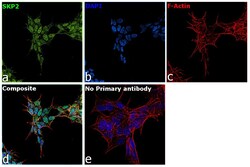
- Experimental details
- Immunofluorescence analysis of SKP2 was performed using 70% confluent log phase SH-SY5Y cells. The cells were fixed with 4% paraformaldehyde for 10 minutes, permeabilized with 0.1% Triton™ X-100 for 15 minutes, and blocked with 2% BSA for 1 hour at room temperature. The cells were labeled with SKP2 Monoclonal Antibody (SKP2-8D9) (Product 32-3300) at 1:250 dilution in 0.1% BSA, incubated at 4 degree celsius overnight and then with Goat anti-Rabbit IgG (H+L), Superclonal™ Recombinant Secondary Antibody, Alexa Fluor 488 (Product # A27034, 1:2000 dilution) for 45 minutes at room temperature (Panel a: Green). Nuclei (Panel b: Blue) were stained with SlowFade® Gold Antifade Mountant with DAPI (Product # S36938). F-actin (Panel c: Red) was stained with Rhodamine Phalloidin (Product # R415, 1:300). Panel d represents the merged image showing nuclear localization. Panel e represents control cells with no primary antibody to assess background. The images were captured at 60X magnification.
- Submitted by
- Invitrogen Antibodies (provider)
- Main image
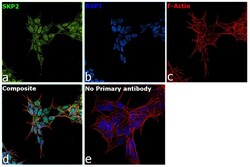
- Experimental details
- Immunofluorescence analysis of SKP2 was performed using 70% confluent log phase SH-SY5Y cells. The cells were fixed with 4% paraformaldehyde for 10 minutes, permeabilized with 0.1% Triton™ X-100 for 15 minutes, and blocked with 2% BSA for 1 hour at room temperature. The cells were labeled with SKP2 Monoclonal Antibody (SKP2-8D9) (Product 32-3300) at 1:250 dilution in 0.1% BSA, incubated at 4 degree celsius overnight and then with Goat anti-Rabbit IgG (Heavy Chain), Superclonal™ Recombinant Secondary Antibody, Alexa Fluor 488 (Product # A27034, 1:2000 dilution) for 45 minutes at room temperature (Panel a: Green). Nuclei (Panel b: Blue) were stained with SlowFade® Gold Antifade Mountant with DAPI (Product # S36938). F-actin (Panel c: Red) was stained with Rhodamine Phalloidin (Product # R415, 1:300). Panel d represents the merged image showing nuclear localization. Panel e represents control cells with no primary antibody to assess background. The images were captured at 60X magnification.
Supportive validation
- Submitted by
- Invitrogen Antibodies (provider)
- Main image
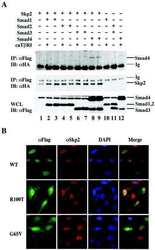
- Experimental details
- NULL
- Submitted by
- Invitrogen Antibodies (provider)
- Main image
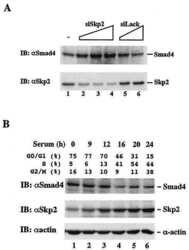
- Experimental details
- NULL
- Submitted by
- Invitrogen Antibodies (provider)
- Main image
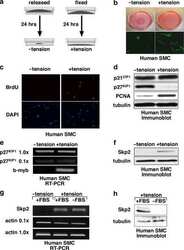
- Experimental details
- NULL
- Submitted by
- Invitrogen Antibodies (provider)
- Main image
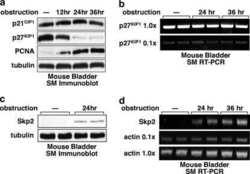
- Experimental details
- NULL
- Submitted by
- Invitrogen Antibodies (provider)
- Main image
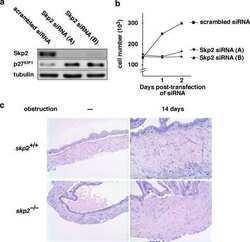
- Experimental details
- NULL
- Submitted by
- Invitrogen Antibodies (provider)
- Main image
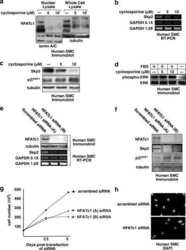
- Experimental details
- NULL
- Submitted by
- Invitrogen Antibodies (provider)
- Main image
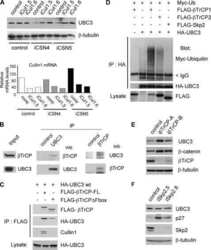
- Experimental details
- NULL
- Submitted by
- Invitrogen Antibodies (provider)
- Main image

- Experimental details
- NULL
- Submitted by
- Invitrogen Antibodies (provider)
- Main image
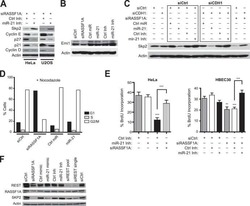
- Experimental details
- NULL
- Submitted by
- Invitrogen Antibodies (provider)
- Main image
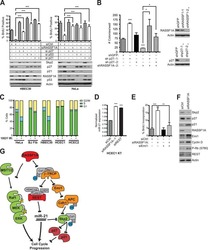
- Experimental details
- NULL
- Submitted by
- Invitrogen Antibodies (provider)
- Main image

- Experimental details
- NULL
- Submitted by
- Invitrogen Antibodies (provider)
- Main image
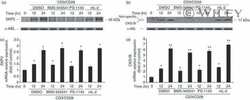
- Experimental details
- NULL
- Submitted by
- Invitrogen Antibodies (provider)
- Main image
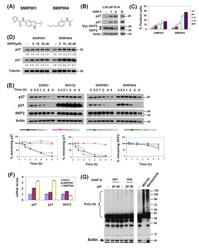
- Experimental details
- Figure 5 Validation of SMIP001 and SMIP004 . (a) Chemical structure of the two small molecule inhibitors of p27 depletions (SMIPs) identified in the screen. (b) Cell lysates from LNCaP-S14 treated with 40 muM SMIPs for 24 h were analysed by immunoblotting. Roscovitine (R) was used as positive control. The data shown is representative of two independent experiments. (c) LNCaP-S14 cells were treated with increasing concentrations of SMIPs (5-40 muM) for 18 h followed by fixation and staining for p27. The graph represents data from 24 replicate wells per concentration. (d) LNCaP-S14 cells were treated with SMIPs (5-40 muM) for 18 h and analysed by immunoblotting for the levels of p27 and p21. (e) p27, p21 and SKP2 stability in LNCaP-S14 cells treated with 40 muM SMIPs for 18 h. Cycloheximide (CHX, 100 mug/mL) was added for the indicated time points prior to preparation of cell lysates and immunoblot analysis. MG132 was used as positive control. The graphs represent the quantification of p27, p21 and SKP2 levels relative to the zero hour time point. The data is representative of three independent experiments. (f) LNCaP-S14 cells were treated with SMIP00s (40 muM) for 18 h followed by extraction of total RNA. The mRNA levels of p27, p21 and SKP2 were quantified by quantitative polymerase chain reaction as described in the Methods section. All data was normalized to GAPDH and is expressed as fold induction. The graph is representative of two independent experiments. (g) Total lysat
- Submitted by
- Invitrogen Antibodies (provider)
- Main image
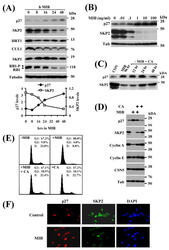
- Experimental details
- Figure 2 Effect of MIB on p27, SKP2, and other cell cycle regulators ( A ) LNCaP cells were incubated with 10 ng/ml MIB for the indicated periods. Cell lysate was harvested and expression of the indicated proteins was assessed by immunoblotting with respective antibodies. Tubulin is shown as a loading control. SKP2 and p27 protein levels were quantitated using a demonstration copy of the Totallab software from Nonlinear Dynamics. ( B ) LNCaP cells were incubated with the indicated concentrations of MIB for 72 h, followed by preparation of total cell lysate and immunoblotting with antibodies against p27, SKP2, and tubulin. The effects of androgen on p27 and SKP2 were maximal at 1 ng/ml MIB. ( C ) LNCaP cells were maintained in the presence of 1 ng/ml MIB for 96 h after which the medium was replaced and 750 ng/ml of the antiandrogen cyproterone acetate (CA) was added. Cell lysates were prepared after the indicated times, and p27 and SKP2 levels were assessed by immunoblotting. ( D ) LNCaP cells were incubated with 1 ng/ml MIB and/or 750 ng/ml CA for 72 h and cell lysates were prepared. Expression of the indicated proteins was assessed by immunoblotting. Tubulin levels are shown as loading controls. ( E ) LNCaP cells were incubated with 1 ng/ml MIB and/or 750 ng/ml CA for 72 h and cells were fixed for flow cytometry. Cell cycle profiles and the fraction of cells in each cell cycle phase are shown. ( F ) LNCaP cells were maintained in the absence or presence of 10 ng/ml MIB for 7
- Submitted by
- Invitrogen Antibodies (provider)
- Main image
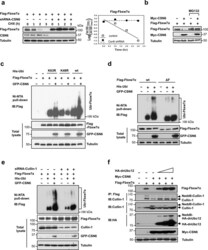
- Experimental details
- Figure 3 CSN6 enhances Fbxw7's autoubiquitination and degradation (a) CSN6 increased Fbxw7alpha turnover. 293T cells were infected with lentivirus to express CSN6 shRNA or luciferase control shRNA. The cells were then transfected with Flag-Fbxw7alpha and were then treated with cycloheximide (CHX; 100 ug/ml) for the indicated times. The density of Fbxw7alpha was measured and the integrated optical density (OD) was measured. The turnover of Fbxw7alpha is indicated graphically. (b) CSN6-mediated Fbxw7alpha downregulation was proteasome-dependent. 293T cells were cotransfected with indicated plasmids and were treated with or without 50 ug/ml MG132 for 6 hours. The cell lysates were then immunoblotted with the indicated antibodies. (c) CSN6 enhanced Fbxw7alpha ubiquitination through lysine 48 linkage. 293T cells were cotransfected with Flag-Fbxw7alpha with or without GFP-CSN6 plus His-ubiquitin wild type (wt), K63R mutant, or K48R mutant. Cells were treated with 50 ug/ml MG132 for 6 hours before harvest. The ubiquitinated Fbxw7alpha proteins were pulled down using Ni-NTA-agarose beads and detected with anti-Flag antibody. (d) An F-box domain deletion mutant of Fbxw7alpha was resistant to CSN6-mediated ubiquitination. 293T cells were cotransfected with GFP-CSN6, His-ubiquitin plus Flag-Fbxw7alpha wild-type or F-box domain deletion mutant (DeltaF). Cells were treated with 50 ug/ml MG132 for 6 hours before harvest. The ubiquitinated Fbxw7alpha proteins were pulled down using Ni-
 Explore
Explore Validate
Validate Learn
Learn Western blot
Western blot ELISA
ELISA Immunocytochemistry
Immunocytochemistry